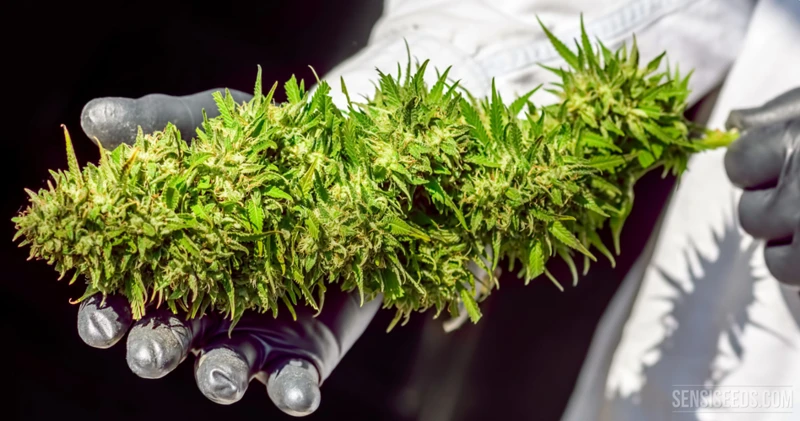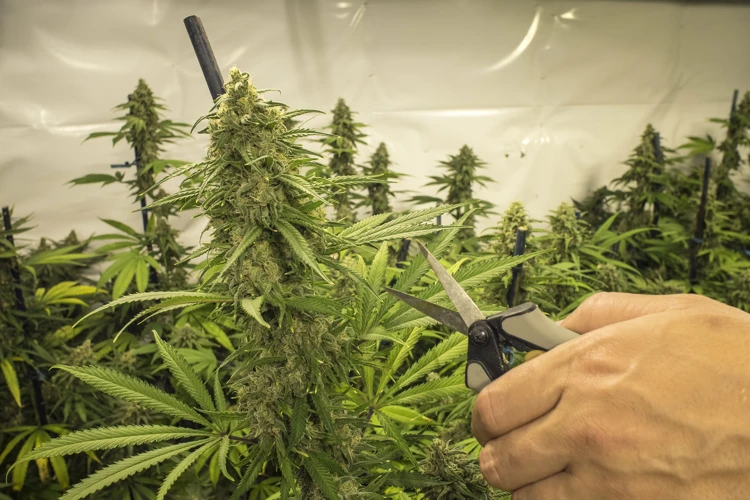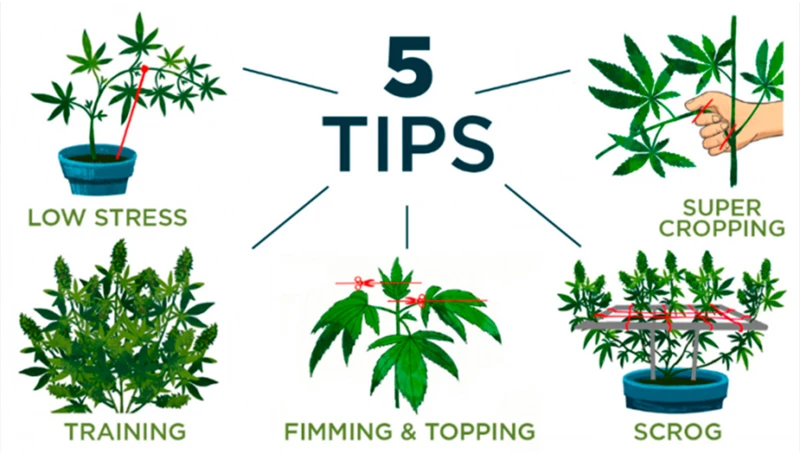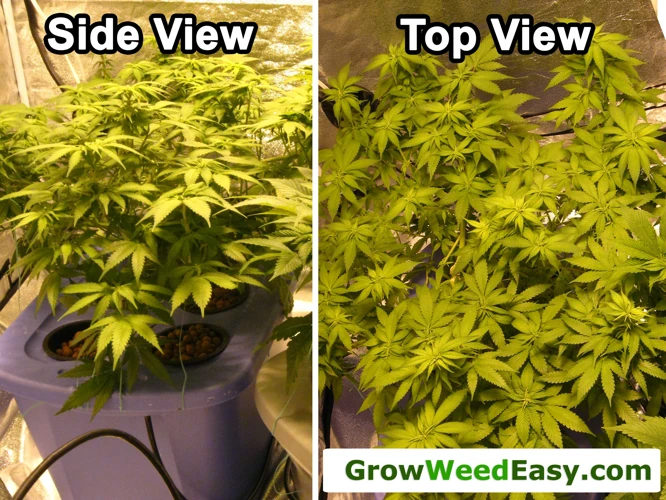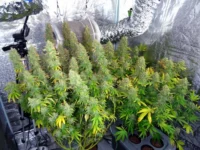
Maximizing Your Cannabis Yield: Tips for Growing High-Yielding Strains
As a cannabis grower, you want to get the best possible yield from each plant. However, maximizing your yield can be a perplexing task, especially if you are not sure where to start. With so many different strains and growing techniques available, it can be overwhelming to know which route to take. In this article, we will break down the tips and tricks you need to know to grow high-yielding strains, from choosing the right strain to optimizing growth conditions, from plant training techniques to harvesting and curing, to overall care tips. So, grab your notepad and let’s get started on your journey to maximizing your yield.
Choosing the Right Strain
Contents
When it comes to growing cannabis, choosing the right strain can be the most crucial decision you make. With so many varieties available, it can be overwhelming to decide which one to cultivate. However, it’s important to keep in mind a few key factors that will help you choose the best strain for your specific growing conditions and yield goals. By considering factors such as yield potential, genetics and lineage, and growing conditions, you can set yourself up for success and maximize your yield.
Consider Yield Potential
Consider Yield Potential: One of the most important factors to consider when choosing strains for high yield is the yield potential of each strain. While yield potential is not the only factor to consider, it is a critical one to ensure that you are maximizing your yield.
To make informed decisions, you should research different strains and their expected yields. This information is usually readily available from seed banks or breeders. To help you make a decision, you can use the following table to compare the yield potential of some popular strains:
| Strain | Average Yield (grams per square meter) |
|---|---|
| White Widow | 400-500 |
| OG Kush | 450-550 |
| Gorilla Glue #4 | 500-600 |
| Green Crack | 450-550 |
| Sour Diesel | 500-600 |
It’s important to note that these numbers are just averages and you can achieve higher or lower yields depending on your growing conditions and techniques. However, these numbers can still be a helpful starting point.
It’s also important to consider any other factors that may affect yield potential, such as genetics and growing conditions. For example, some strains may have a lower yield potential but may be better suited to your specific growing conditions, which may ultimately result in a higher yield for that strain.
In general, when considering yield potential, be sure to take a holistic view of all the factors that can impact yield and make an informed decision based on your unique circumstances.
Look at Genetics and Lineage
One important factor to consider when choosing a high-yielding strain is the genetics and lineage of the plant. Genetics can have a significant impact on yield potential, as well as the overall growth patterns and characteristics of the plant.
To help you make an informed decision, it’s worth doing some research on the different strains available and their genetic backgrounds. You can use the following table as a guide to help you compare different strains and their characteristics:
| Strain | Genetic Background | Average Yield | Growth Characteristics |
|---|---|---|---|
| OG Kush | Hindu Kush x Chemdawg | 450-550 g/m² | Short and bushy, ideal for indoor growing |
| Super Silver Haze | Skunk x Haze x Northern Lights | 550-650 g/m² | Tall and slender, may require additional support during flowering |
| Gorilla Glue #4 | Sour Dubb x Chem Sis x Chocolate Diesel | 500-600 g/m² | Medium height and density, responds well to training techniques |
Keep in mind that average yields may vary depending on a range of factors, including growing conditions, plant care, and individual plant genetics. It’s also worth noting that some strains may have a longer flowering period, which can impact overall yield and growth characteristics.
When considering genetic background, it’s also worth looking at the lineage of the strain. This can help you understand how the plant has been bred and what characteristics it is likely to exhibit. For example, a strain with a strong Sativa lineage is likely to have a more uplifting and cerebral effect, while a strain with a strong Indica background may be more relaxing and sedative.
Taking the time to research and understand the genetic background and lineage of different strains can help you make a more informed decision when choosing a high-yielding plant.
Consider Your Growing Conditions
When choosing a high-yielding strain to grow, it’s important to consider your growing conditions and how they will affect the plant’s growth. Factors such as climate, light availability, and soil type can all impact the final yield.
One way to assess your growing conditions is by using a table, like the one below:
| Growing Condition | Impact on Yield |
|---|---|
| Climate | Temperature and humidity levels can affect the plant’s growth and overall health. Consider if your climate is suitable for your chosen strain. |
| Light Availability | Plants require a certain amount of light to grow and produce buds. Assess the amount of natural light available or consider using grow lights. |
| Soil Type | The nutrients and pH levels in the soil can also impact the plant’s growth. Consider testing the soil and adding any necessary amendments. |
| Water Quality | Plants are sensitive to the quality of water they receive. Make sure the water you use is free from pollutants and has the right pH level. |
| Air Circulation | Good air circulation is important for preventing disease and mold from developing in the growing area. Make sure there is adequate ventilation. |
Taking into account your growing conditions and making any necessary adjustments can help ensure the optimal yield and quality of your cannabis plants.
Optimizing Growth Conditions
Achieving optimal growth conditions for your plants is essential to maximizing your yield. It can be a difficult task that requires a lot of attention to detail, but the results are well worth it. With the right combination of temperature and humidity, lighting, soil and nutrients, you can create an environment that encourages healthy growth and a bountiful harvest. Let’s delve into the various elements that go into optimizing growth conditions for high-yielding strains.
Temperature and Humidity
Maintaining the right temperature and humidity levels is crucial for a high-yielding grow. The ideal temperature range for most strains is between 20-28°C during the day and 18-24°C at night. The humidity, on the other hand, should be around 50-60% during the vegetative stage and 40-50% during flowering stage to prevent mold growth.
To achieve these levels, consider investing in a temperature and humidity monitor. This will help you keep track of your grow room’s conditions and make adjustments accordingly. Here’s a table with some temperature and humidity tips:
| Temperature Troubleshooting | Humidity Troubleshooting |
|---|---|
| Too hot: If temperatures are too high, plants may suffer from heat stress or nutrient deficiencies. Consider increasing ventilation or using a cooling system like an air conditioner or fans. | Too high: High humidity can lead to mold growth and bud rot. Use a dehumidifier or increase airflow to lower humidity levels. |
| Too cold: If temperatures are too low, it can slow growth or cause nutrient lockout. Use a space heater or increase insulation to warm up the room. | Too low: Low humidity can cause plant stress, slow growth, or encourage pests. Increase humidity with a humidifier or by using a wet towel to cover a container of water. |
Properly regulating the temperature and humidity in your grow room can significantly improve plant growth and yield. Keep an eye on your levels and make adjustments as necessary to ensure your plants are receiving the best possible care.
Lighting
When it comes to maximizing the yield of your cannabis plants, the lighting you use is critical. Here are some tips to help you make the most of your lighting:
- Choose the Right Type of Lighting: There are several different types of lighting available for growing cannabis, including fluorescent, halogen, LED, and high-pressure sodium (HPS). Each has its pros and cons, so it’s important to choose the type that best fits your grow room and budget.
- Provide Adequate Light Intensity: Cannabis plants need a certain amount of light intensity to grow and produce a high yield. Make sure your lighting system provides enough light to cover your entire grow space and that your plants are getting enough light each day.
- Control the Light Cycle: Cannabis plants need a balance of light and darkness to grow properly. During the vegetative stage, they need 18-24 hours of light per day, while during the flowering stage, they require 12 hours of light and 12 hours of darkness. Make sure to set up a timer to ensure your plants get the right amount of light and darkness each day.
- Consider the Distance: The distance between your plants and your lighting system is important. If your lights are too close, they can burn your plants, but if they’re too far away, your plants won’t get enough light. Make sure to follow the manufacturer’s instructions for optimal distance.
- Upgrade Your Lighting System: If you’re not happy with the yield you’re getting, consider upgrading your lighting system. High-quality LED or HPS lights can make a big difference in yield and potency.
By following these lighting tips and providing your cannabis plants with the right amount and type of light, you can help maximize your yield and produce high-quality buds.
Soil and Nutrients
To achieve high-yielding strains, it’s important not to overlook the significance of soil and nutrients. Here are some tips to help you optimize your soil and nutrient conditions for the best yields possible:
1. Choose the Right Soil: When planting high-yielding strains, the type of soil you choose is critical. Look for high-quality soils that are rich in nutrients and well-aerated. Avoid soils with too much clay, sand, or rock, as they can negatively affect nutrient retention and drainage.
2. Use Nutrient-Rich Soil Additives: Organic compost, worm castings, and bat guano are all examples of nutrient-rich soil amendments that can help improve soil quality and increase yields.
3. Consider Nutrient Supplements: In addition to using high-quality soil, supplementing nutrient levels during different stages of growth can help your plant thrive. Choose fertilizers that are specifically formulated for the type of plants you are growing.
4. Be Mindful of Soil pH: Soil pH levels play a crucial role in nutrient absorption, so it’s important to measure and adjust pH levels to suit your crop’s needs. Most plants thrive in a slightly acidic soil with a pH between 6.0 and 7.0.
By paying attention to the soil and nutrient conditions that your plants are growing in, you can help maximize yields and ensure a healthy, thriving crop.
Plant Training Techniques
For growers looking to maximize their yield, plant training techniques can be a game-changer. By manipulating the growth of your plants, you can encourage the development of multiple cola sites and create a more even canopy. This can increase light penetration, reduce the risk of mold and pests, and ultimately result in a higher yield. In this section, we’ll explore some popular plant training techniques – from topping to SCROG – and how they can be used to grow high-yielding strains. So, let’s dive into the world of plant training and see how you can take your grow to the next level!
Topping
Topping is a plant training technique that involves cutting off the top part of the plant’s main stem, which divides it into two main colas. This technique is used to increase the number of colas a plant grows, which in turn increases the yield.
To perform topping correctly, it’s important to wait until the plant has grown at least five nodes or sets of leaves, and then use clean, sharp scissors or pruning shears to cut off the top of the main stem just above the fifth node. After topping, the plant will redirect its energy to other areas, resulting in more colas and ultimately more bud.
Benefits of Topping:
– Increased number of colas
– Increased yield
– Improved light distribution
– Improved airflow
Drawbacks of Topping:
– Slower growth initially after topping
– Can stress the plant if done incorrectly or too early
– Increased maintenance required to manage additional colas
When using topping as a plant training technique, it’s important to ensure that the plant has enough time to recover before moving on to other training techniques or entering the flowering stage. It’s also important to monitor the plant closely to ensure that it’s responding positively to the new growth pattern.
LST (Low Stress Training)
Low Stress Training, or LST for short, is a plant training technique that involves bending and tying down the plant’s branches to encourage horizontal growth. This allows for a lower canopy, maximizing light exposure to all parts of the plant, which results in higher yields.
How to Perform LST
Performing LST is a relatively simple process that can be done by following these steps:
| Step | Description |
|---|---|
| Step 1 | Identify the main stem of the plant and gently bend it over to one side. |
| Step 2 | Use soft plant ties to gently pull down the branches, creating a horizontal plane. |
| Step 3 | Repeat this process with all the branches, making sure not to cause any damage to the plant. |
| Step 4 | Continue this process throughout the vegetative stage, until the desired canopy level is achieved. |
Benefits of LST
There are several benefits to using LST as a plant training technique. Some of these include:
- Maximizing light exposure to all parts of the plant.
- Improving air circulation, which reduces the risk of mold and mildew.
- Encouraging the growth of multiple colas, resulting in higher yields.
- Maintaining an even canopy for easier maintenance and harvest.
- Reducing the overall height of the plant, which can be beneficial for those with limited growing space.
Things to Keep in Mind
While LST is a relatively low stress plant training technique, it is important to keep a few things in mind when performing it:
- Be gentle when bending and tying down the branches to avoid breaking or damaging them.
- Monitor the plant regularly to make sure that the ties are not causing any harm or restricting the plant’s growth.
- Make sure to provide adequate support for the branches to prevent them from breaking or falling over.
- LST should be performed during the vegetative stage of the plant’s growth cycle, as it can cause stress and reduce yields if done during the flowering stage.
By using LST as a plant training technique, growers can maximize their yields and produce high-quality cannabis.
SCROG (Screen of Green)
One plant training technique that can maximize yield is called Screen of Green (SCROG). This technique involves placing a screen above the plants and weaving the branches through the screen as they grow. This allows for more branches to receive direct light, resulting in larger and more plentiful buds.
To set up a SCROG, growers will need a screen or netting that can be placed over the plants. This should be supported by a frame that can be adjusted as the plants grow. Once the screen is set up, the plants can be trained by gently bending and weaving the branches through the holes in the screen. This should be done carefully to avoid damaging the plants.
The SCROG technique is particularly useful for indoor growers who are restricted in terms of height. By keeping the plants low and spreading them out, growers can maximize their use of space and increase yield. It can also help to even out the canopy and ensure that all branches receive adequate light.
While the SCROG technique can be effective, it does require some additional maintenance. Growers will need to regularly check on the plants and adjust the screen as needed to prevent overcrowding or damage to the plants. It’s also important to monitor for pests and disease, as the screen can create a humid environment that is ideal for these issues.
The SCROG technique is a great option for growers looking to maximize their yield without increasing the number of plants. With careful training and maintenance, growers can achieve impressive harvests using this method.
| Pros | Cons |
| -Maximizes use of space | -Requires additional maintenance |
| -Increases yield per plant | -Can create humid environment for pests and disease |
| -Even out the canopy | -Requires careful training to avoid plant damage |
Harvesting and Curing
As the long-awaited harvest approaches, it’s crucial to remember that the work isn’t over yet. Properly harvesting and curing your buds is essential to maximize their potency and flavor. This process can be perplexing for beginners, but fear not – we’ve got you covered. In this section, we will explore the important steps to take when cutting down your plants and curing your buds to perfection. So, let’s dive in and learn how to finish off your growing season with a bang!
Timing the Harvest
When it comes to maximizing your yield, timing the harvest is a crucial step. It can greatly affect the potency and flavor of your cannabis buds. Here are some important factors to consider when determining the best time to harvest your cannabis plants:
- Pistil color – One of the most common ways to judge the readiness of your cannabis plants is by looking at the pistils. Pistils are the tiny, hair-like structures that protrude from the buds. As the plant matures, the pistils will start to change color from white to orange or brown. When about 70-80% of the pistils have changed color, it’s usually a good time to start harvesting.
- Trichome color – Another helpful indicator of readiness is the color of the trichomes. Trichomes are the tiny, crystal-like structures that cover the buds. When the trichomes are mostly cloudy and have some amber or brown color, it’s a sign that the THC is at peak potency.
- Flowering time – Different strains have different flowering times, which is the amount of time it takes for the plant to develop buds after the light cycle has been switched to 12 hours of darkness. Knowing the flowering time of your strain can help you determine when to start checking for readiness.
It’s also important to note that harvesting too early can result in a lower yield and weak potency, while harvesting too late can lead to a more sedative effect and less flavorful buds. So, be sure to pay close attention to the aforementioned factors and perform regular inspections to ensure that you’re harvesting at the right time.
Drying and Curing
The drying and curing process is a crucial step in maximizing the yield and potency of your cannabis. Here are a few key tips to keep in mind during this stage:
- Hang dry the buds: Once you have harvested your plants, it’s important to trim off any excess leaves and then hang the buds upside down to dry. This allows the moisture to be distributed evenly and helps prevent mold from forming. Hang the buds in a cool, dark place with good air flow.
- Monitor humidity levels: During the drying process, you want to keep the humidity levels between 45-55%. This helps prevent the buds from drying out too quickly or too slowly, which can affect flavor and potency.
- Burp the jars: After the buds have dried for about a week, it’s time to move them into jars for the curing process. It’s important to “burp” the jars daily by opening them for a few minutes to release any excess moisture. This helps prevent mold and ensures the buds cure evenly.
- Cure for at least 2-4 weeks: The longer you can cure your buds, the better the flavor and potency will be. Aim for at least 2-4 weeks, but some growers prefer to cure for several months.
- Store buds in a cool, dark place: Once your buds are fully cured, store them in a cool, dark place to maintain their potency and flavor. Avoid exposing them to light or heat, which can degrade the cannabinoids and terpenes.
By following these drying and curing tips, you can maximize the yield and quality of your cannabis harvest. Remember, patience is key when it comes to curing – the longer you wait, the better the end result will be.
Overall Care Tips
Once you’ve chosen the right strain and optimized your growing conditions, it’s crucial to maintain overall care to ensure a successful harvest. Regular inspections and pest control measures are just a few of the important steps to take. In this section, we’ll discuss some key tips for overall plant care to make sure your high-yielding strains reach their full potential. So, let’s dive in and explore these essential tips for maximizing your yield!
Regular Inspections
Regular inspections are essential to ensure the health and vitality of your plants. Inspecting your plants on a regular basis will allow you to catch any potential problems before they become serious issues, which will ultimately maximize your yield. Here are a few tips to keep in mind when inspecting your plants:
- Check for pests: Look closely at both the tops and bottoms of leaves to see if there are any pests or signs of pest infestations, such as webs, holes, or brown spots.
- Look for signs of disease: Watch for leaves that are discolored, wilted or deformed, as these could be signs of disease. Be sure to remove any diseased leaves to prevent the spread of infection.
- Check for nutrient deficiencies: Pay attention to the color and texture of leaves. If the leaves are yellow, brown or have spots, it could indicate a nutrient deficiency.
- Monitor growth: Check to make sure that your plants are growing at a healthy rate. If they are not growing as fast as they should or are showing signs of stunted growth, it could indicate a problem with your growing conditions.
By regularly inspecting your plants, you can catch any potential problems early on and take steps to address them before they become serious. This will help ensure that your plants stay healthy and ultimately maximize your yield.
Pest and Disease Control
When cultivating high-yielding strains, it is essential to ensure that your plants remain healthy and free from pests and diseases. Here are some essential pest and disease control measures to incorporate into your growing routine:
| Control Measure | Description |
|---|---|
| Preventive Measures | Preventive measures are essential to keep pests and diseases at bay. One of the most effective ways to prevent pest infestations is to keep your grow area clean and tidy. Regularly remove dead plant matter, debris, and spilled soil or nutrients that can attract pests. Additionally, ensure that your growing conditions are optimal and avoid overfeeding your plants. |
| Identify the Problem | Early detection of pest infestations or diseases is crucial for effective control measures. Regularly inspect your plants for signs of pests, such as mites, aphids, and thrips. If left untreated, pests can cause significant damage to your plants and lower your yield. Additionally, look out for symptoms of diseases, including wilting, yellowing, or spotting of leaves, which can also affect crop health and yield. |
| Natural Pest Control | Natural pest control methods can be effective in controlling pest populations without resorting to harmful chemicals. Introducing beneficial insects, such as ladybugs or praying mantises, can help control common pest populations. Additionally, neem oil, garlic oil, and other organic sprays can help repel pests when used regularly. |
| Chemical Pest Control | If natural pest control methods are not effective, it may be necessary to resort to chemical pest control. However, it is essential to use pesticides and herbicides responsibly and safely. Always read the label instructions and use the recommended doses. Additionally, avoid spraying during the flowering stage to prevent chemical contamination of your buds. |
| Isolate Infected Plants | If you notice that one of your plants is infected, isolate it immediately to prevent the spread of pests or diseases to other plants. Treating an infected plant can be challenging, and it is usually easier and safer to dispose of it entirely. |
By incorporating these pest and disease control measures into your growing routine, you can ensure that your plants remain healthy and produce high yields. Remember that prevention is always better than cure, and taking proactive measures to prevent pest and disease infestations is crucial for successful cultivation.
Conclusion
In conclusion, growing high-yielding strains requires attention to detail and a proper understanding of the growing process. From choosing the right strain to optimizing growth conditions, plant training techniques, and harvesting and curing methods, every step along the way can impact the final yield.
Choosing the right strain is the first step to success. Consider yield potential, genetics and lineage, and growing conditions before making a choice.
Optimizing growth conditions involves finding the right balance of temperature, humidity, lighting, and soil/nutrients. Paying careful attention to these factors can help maximize yield potential.
Plant training techniques, such as topping, LST, and SCROG, can help the plant grow in a way that maximizes yield potential. Each technique has its own benefits and drawbacks, and experimentation may be needed to determine what works best for your situation.
Harvesting and curing the plant carefully and at the right time is critical to maximizing yield potential. Timing the harvest, drying, and curing can all impact the final yield and quality of the product.
Overall care tips including regular inspections and pest and disease control can help maintain the health of the plant and optimize yield potential. Regular inspections can prevent problems from becoming too severe, while pest and disease control measures can prevent losses in yield.
By taking these steps, growers can increase their chances of growing high-yielding strains. Careful attention to detail, experimentation, and a willingness to learn from mistakes can help improve yields over time. Remember, the growing process is a journey, and each step is an opportunity to learn and improve.
Frequently Asked Questions
What is the average yield for cannabis plants?
The average yield for cannabis plants varies greatly depending on the strain and growing conditions, but generally falls between half an ounce and two pounds per plant.
Can I grow high-yield strains indoors?
Yes, high-yield strains can be grown indoors with the right lighting, soil, and plant training techniques.
What lighting is best for maximizing yield?
LED grow lights are the most efficient and effective for maximizing yield, but high-pressure sodium (HPS) lights can also be effective.
How often should I water my cannabis plants?
Cannabis plants should be watered when the top inch of soil feels dry to the touch. Overwatering can lead to root rot, while underwatering can stunt growth and lower yield.
What nutrients are essential for maximizing yield?
Cannabis plants need a balance of nitrogen, phosphorus, and potassium (NPK), as well as micronutrients like magnesium and calcium. Using a high-quality fertilizer with the right balance of nutrients can help maximize yield.
What is topping and how does it affect yield?
Topping is a plant training technique that involves cutting off the top of the main stem to encourage more lateral growth. This can lead to more bud sites and a higher yield.
What is SCROG and how does it affect yield?
SCROG (Screen of Green) is a plant training technique that involves using a screen to keep the plants low and wide, allowing for more bud sites and a higher yield.
How should I store my harvested cannabis?
Harvested cannabis should be stored in an airtight container in a cool, dry place to preserve potency and prevent mold and mildew.
What are common pests and diseases that can affect cannabis plants?
Common pests include spider mites, thrips, and aphids, while common diseases include powdery mildew and bud rot. Regular inspection and preventative measures can help control these issues.
Is it legal to grow cannabis for personal use?
Legality of growing cannabis for personal use varies depending on location. It is important to research local laws and regulations before growing cannabis.

